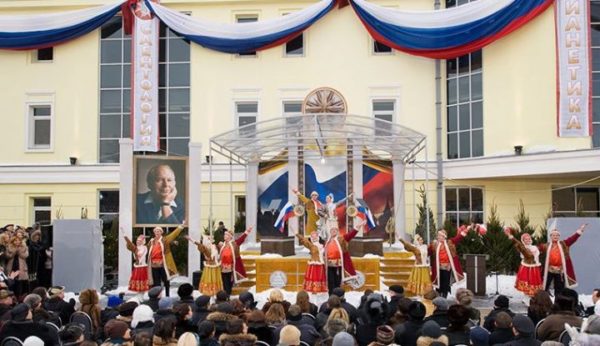
For some time now we’ve been nudging historian Chris Owen to help us understand what is going on with Scientology in Russia. We’ve seen news reports about numerous police raids of orgs there, and we’ve read about a prosecution involving some real estate fraud, but what are we to think about it?
Thankfully, Owen has done the deep dive we were hoping for, and that he’s known for. Today, we have part one of a three-part series he has written after extensive research into the history of Scientology in Russia, and which will bring us right up to what’s happening today. First, he looks back at Scientology’s invasion of that country up to the beginning of Vladimir Putin’s reign.
Scientology in Russia: 1. Planetary Expansion in the former Soviet Union
Over the past 20 years, one of the bitterest conflicts between Scientology and a state has been playing out in Russia. Scientology was spectacularly successful in post-Soviet Russia in the 1990s. However, since the accession of President Vladimir Putin in 1999 it has come under increasingly sustained pressure from the Russian government.
Russia is virtually the only country in the world currently taking serious action against Scientology. Orgs in Russia have repeatedly been raided by police and the Federal Security Service (FSB, the successor to the KGB). Five Scientologists are currently on trial in St Petersburg on charges of money laundering and extremism. However, the Russian government’s actions against Scientology have been criticised by human rights groups and the US government, and come against the background of increasingly authoritarian rule and a controversial crackdown against foreign faith groups.
Scientology has responded defiantly to the various charges and raids, and has attributed them to an anti-Scientology conspiracy. “The Russian intelligence services] use drug hypnosis and brainwash people to follow certain orders,” claims Scientology spokesperson Nina de Castro. “And Scientology and Dianetics can take out all these things. In order not to have problems later, today we do not take people who worked in the special services, people who already have implants installed. Attacks are coming because of this.”
Scientology first reached Russia as early as 1984, when a Leningrad professor brought a copy of Hubbard’s 1950 book Dianetics: The Modern Science of Mental Health back from a visit to Germany. He had it translated into Russian and circulated it informally among his contacts. The Church of Scientology took longer to establish an official presence in Russia. It attempted to do so unsuccessfully as early as 1988, but was thwarted by the heavy restrictions on religious freedoms under Soviet rule.
Mikhail Gorbachev’s liberalisation of religion in the Soviet Union in 1990 gave Scientology its first opening. That year, an official delegation comprising Soviet cosmonaut Pavel Popovich, narcotics specialist Vladimir Ivanov, Izvestia newspaper deputy editor-in-chief Igor Andreyev and general director Leonid Todorov of the Soyuz Theater visited the UK as guests of Scientology’s drug rehabilitation front group Narconon.
The delegation agreed to establish a Narconon facility with 400 beds in Moscow to tackle the capital’s drug and alcohol abuse problems. Ivanov subsequently became the head of Narconon in Russia and was later appointed to head the Russian government’s drug prevention programme. He later broke with Scientology and publicly denounced it as ”a rabid, aggressive commercial organisation” which had appropriated drug rehabilitation treatment “in a completely ugly manner”.
The following year, the former senior Guardian’s Office executive and unindicted co-conspirator David Gaiman collaborated with the Russian Academy of Medical Sciences to find uses for Hubbard’s unproven ‘purification rundown’ in treating Chernobyl radiation victims. Scientology subsequently established a network of narcotics and alcohol treatment centres in Russia, utilising Hubbard’s methods.
The fall of the Soviet Union ushered in an era of unprecedented religious and economic freedom across the region. In most of the former Soviet republics, the doors were thrown open for previously banned faith groups and much of the economy was privatised. Scientology was quick to take advantage.
In 1992, only a few months after the dissolution of the USSR, three Scientology ‘pioneers’ travelled to the newly independent Russian Federation to establish a presence there: Lynn Irons, a former Scientology mission holder and executive director; Geoff Barton; and another former senior GO executive and unindicted co-conspirator, Arte Maren. In the same year, Dianetics: The Modern Science of Mental Health was published in Russia for the first time.
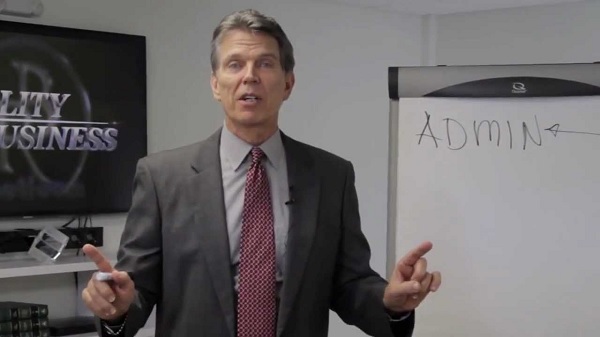
It was a sign of how successfully Scientology had engaged with the new Russian elite that the book received its official launch in the Kremlin, in a building that had formerly housed the Communist Party’s annual conferences. Future FSB director Sergei Stepashin praised Hubbard as “the world’s most humane humanist”, while Vice-President Alexander Rutskoy was familiar enough with Dianetics that he quoted it in a newspaper interview.
The Scientology leadership saw the former Soviet Union as an ideal area for growth. The region had a highly educated, urbanised population with an increasingly wealthy elite, eager for new Western thinking to replace outdated Soviet nostrums. In the words of Ron Kule, one of the pioneers of Scientology’s Russian expansion, “Russia was our best bet for overall expansion on a planetary basis.”
Scientology’s Office of Special Affairs (OSA) was heavily involved in this push, which was guided by the grandiosely-termed OSA CIS Master Program. It established an Operations Transport & Liaison (OTL) mission in 1992 to oversee Scientology’s activities in Russia and the other states of the post-Soviet Confederation of Independent States (CIS). OTL Russia was a miniature version of Scientology’s main European continental liaison office (CLO EU) in Copenhagen and was staffed by ex-CLO EU members.
Leading it was Walter Kotric, a veteran Austrian Scientologist who later became the church’s head of operations in continental Europe (CO CLO EU). The other two were the newly-appointed Commanding Officer OSA CIS, Diethelm Alisch, and his Public Relations Officer, Birthe Heldt. OSA set about creating a Russia-wide network, but was hampered by a lack of English-speaking staff which prevented it from implementing the usual ‘security checking’ needed to qualify them.
OTL Russia was a well-funded and well-organised operation. Money helped to facilitate Scientology’s outreach, as demonstrated by its success in establishing a particularly close relationship with Russia’s oldest university, the Moscow State University. The MSU’s faculty of journalism not only bestowed a posthumous doctorate on Hubbard – the first in the university’s history – but also renamed the faculty’s hall as the “L. Ron Hubbard Hall of Moscow State University”, also known as the L. Ron Hubbard Reading Room.
The room was refurbished and re-equipped at the church’s expense. Perhaps not surprisingly, Scientology turned it into a virtual shrine to Hubbard, with pictures of him decorating the corridors, Scientology propaganda on the walls and a bronze bust of him in pride of place. Cynical Russians dubbed it a khalyava or freebie; in exchange for giving Scientology a publicity boost, the university got a much-improved facility.
The first Russian Scientology org was opened in St Petersburg in 1992. A “Hubbard Humanitarian Center” was established in Moscow in 1993 and became Russia’s first Church of Scientology the following year. It was founded by Vladimir Kuropyatnik, a Russian radio engineer who was recruited by a Swedish Scientologist who had interviewed him for a job opening. He had attended a Dianetics seminar at the Moscow State University in 1992 and studied Scientology in Copenhagen, before establishing the Moscow org on his return to Russia.
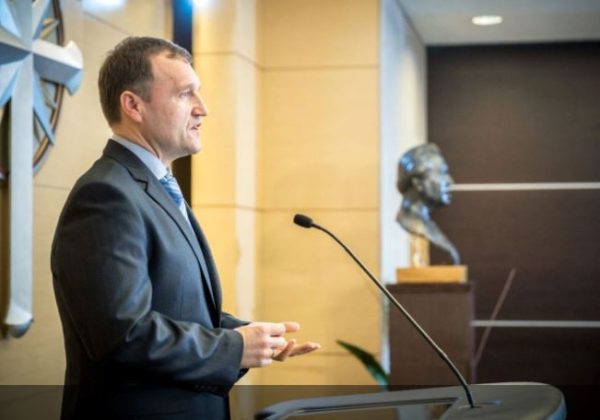
By May 2011, Scientology claimed 500,000 followers in Russia (though that figure was greatly exaggerated, as elsewhere). It had around 70 orgs in 50 Russian regions and more in other former Soviet republics. However, the only one registered as a religious organisation was that in Moscow. The rest were registered as “public social non-profit organisations”.
Scientology’s rapid growth in Russia was boosted by an approach tailored to a region in a breakneck transition to capitalism. As well as its traditional pitch of personal development, Scientology promoted itself as a business management and training solution. Soviet schools had not taught administration, leaving a huge gap in knowledge that Scientology was quick to exploit. It did not generally advertise itself as a religion but operated instead under the guise of a network of “Dianetics groups” and “Hubbard Colleges of Management”. There was also, at the time, a lack of independent information on Scientology in the Russian language. It benefited greatly from its glamorous association with Hollywood stars and Russians’ fascination with all things Western.
According to Russian media reports, Scientology also established several hundred front groups which represented themselves as medical, scientific and educational institutions. The Scientology front group WISE (World Institute of Scientology Enterprises) set up a Russian arm, known in Russian as the Institute of Economics.
By 1998, WISE was reported to have enrolled dozens of Russian banks and many industrial and telecoms enterprises. WISE licensed a network of Scientologist-run consulting companies which resold Hubbard’s ‘management technology’ to other firms. It also extended its reach across the country by offering courses through the auspices of the State Academy of Industrial Management, which has branches in over 50 Russian cities.
Its expansion was aided by entrepreneurs in the ex-Soviet republics who viewed Scientology uncritically as a “new science of prosperity and success”. WISE appears to have focused particularly on newly-privatised state firms across the former Soviet Union, convincing some executives to indoctrinate their entire workforces. In Uzbekistan, Scientology sought the support of executives from the Tashkent Aviation Production factory to open a “Hubbard Center” and “Dianetics Center” within the facility. It aimed to train the giant plant’s tens of thousands of workers in Hubbard’s management methods. A similar project was established at the huge Altron chemical works in Novgorod in Russia.
Scientology undoubtedly earned huge amounts from its business training. In one case, the Moscow fan company Moven’s adoption of ‘management technology’ reportedly cost it a billion rubles. The company imported Hubbard’s harsh regime of ‘management by statistics’ and ‘knowledge reports’ in a years-long relationship with WISE. It ended only when Moven’s pro-Scientology chief executive, Alexander Mironov, was assassinated in his own office by the personnel manager whom he had put in charge of implementing ‘management tech.’ Scientology also courted the Russian media and cultivated allies who commissioned favourable broadcasts and news reports, promoting Hubbard’s ideas to the wider population.
Scientology even managed to convince public administrators to put Hubbard’s ideas into practice in state organisations. In August 1994, the Russian health ministry approved the use of Hubbard’s ‘purification’ methods by state-funded healthcare providers, under licence from Narconon. Scientology also carried out a project to get Hubbard’s ‘touch assists’ – essentially healing by laying on hands – approved for use in government hospitals. A number of schools and kindergartens around Moscow and the Moscow region adopted Hubbard’s ‘study technology’, licensed by the Applied Scholastics front group.
Developing what Scientology calls “power comm lines” – cultivating influential allies – was a crucial element of the strategy. Hubbard established this approach as long ago as the 1950s and developed it into a systematic approach that is still pursued worldwide. It is intended to give Scientology early warning of impending state actions, help to smooth over difficulties with state agencies, and exert influence over possible threats to Scientology.
In one example, OSA’s Director of Special Affairs in St Petersburg put pressure on an aide to the city’s powerful Mayor, Anatoly Sobchak – a mentor of future president Vladimir Putin – to prevent local newspapers publishing articles critical of Scientology. After being “gradually handled”, wrote OSA CIS head Alisich, the aide “stated that there won’t be any more entheta media in St. Petersburg.” Two planned articles were not published. “Perhaps the meetings brought about the killing of these other two entheta articles”.
The church deliberately sought to recruit from among Russia’s political elite and government officials. Alisich reported in March 1996: “On our lines are former regional governors, the director of the most popular TV show of all Russia, the director of one of the Russian banks, deputy directors and chairmen from other banks, government employees, and others.” A 1998 memo seized from the Moscow org reportedly identified police and interior ministry officials as high-priority targets for Scientology training.
WISE’s influence eventually reached far into Russia’s elite. One of Boris Yeltsin’s prime ministers, Sergei Kiriyenko, became the subject of a controversy when a German newspaper revealed that while he was working as the head of a bank, he had taken a Scientology management course. He also sent some of his employees to study at the Hubbard College in Nizhny Novgorod, which had become a fashionable destination for many of the local elite. He would likely have been regarded by Alisich as an ‘ally’, though whether the church ever called on him for help is unknown. Vladimir Fil, the mayor of the West Siberian city of Perm, was so enthusiastic about Scientology that he publicly promised to have the entire city administration utilising Hubbard’s ‘management technology’ within a year. The experiment did not last long, as Fil was defeated by a wide margin in the 1996 elections.
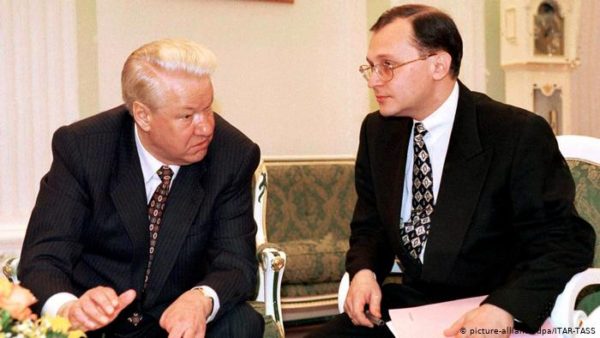
OSA appears to have recruited a network of agents and sources within Russian state agencies, including in law enforcement and the FSB – the domestic intelligence service and successor to the KGB. In another leaked report, this time from October 1996, a Russian OSA member reported to Alisich: “The source from KGB [sic] said that they have sent an order from the federal FSB to investigate Scientology”. The source disclosed that “the FSB hadn’t recommended to conduct active operations. The source said that actions wouldn’t be conducted but they would secretly surveil and observe.”
OSA also seems to have obtained information from Russian Scientologists who were either well placed in state organisations or had well-placed relatives. According to leaked cables, OSA was appraised of the intentions of the District Attorney in Voronezh by a Scientologist who had an uncle on the DA’s staff. The brother of another Scientologist was a chairman of religious affairs in the Moscow city government and tipped off his sister of the government’s plans to close down Scientology in the city. A Moscow Scientologist was himself a prosecutor who worked for the Attorney General’s office. Although his colleagues were aware of his affiliations and (rightly, as it turned out) did not trust him with information, he found out about the office’s plans to prosecute Scientology and tipped off OSA.
Scientology’s belief that it is constantly in danger of being infiltrated reflects Hubbard’s usually baseless paranoia. In this case, though, it almost certainly was infiltrated by Russian state agencies, which typically view foreign-led groups with deep suspicion. A March 1998 report noted that a source had reported that “there are FSB agents inside our orgs who give data to FSB”. Intelligence from FSB agents has almost certainly played a significant factor in influencing the Russian government’s views on Scientology; according to a Russian journalist in 2016, “[the] Scientologists were under FSB observation for a long time.”
Scientology’s expansion in Russia met concerted opposition from three particular quarters in Russian society: parents who found themselves estranged from their Scientologist children and set up ‘Parents’ Committees’ to campaign against cults; the Russian Orthodox Church; and eventually the Russian national and regional governments. The most persistent and perhaps the most influential source of opposition has been the Russian Orthodox Church, which has been outspoken in its criticism of Scientology.
Orthodox Christianity occupies a central role in Russia’s culture and politics. 70% of Russian citizens and 90% of ethnic Russians follow Russian Orthodoxy. As in many other Orthodox countries, the Orthodox Church is seen as the spiritual guardian of the country and Orthodox Christianity is regarded as a defining part of national identity.
The sudden arrival of numerous non-Orthodox and non-Christian sects in Russia in the early 1990s presented a huge challenge to the Orthodox Church’s traditional authority. It was seen by the Church as a grave threat to the nation’s religious unity and morality. The Church’s Council of Bishops issued a declaration in December 1994 describing “pseudo-religions” as destructive to “the traditional foundations of life that have been formed under the influence of the Orthodox Church, and the moral and spiritual ideal that we all share, and threaten the integrity of our national consciousness and cultural identity.” Scientology, in particular, was condemned as a “pseudo-religion imported from the West”.
The Orthodox Church’s hostile view of Scientology was greatly influenced by contacts with Western anti-cult groups, including religious organisations; mainstream churches in both Greece and Germany had become frequent critics of Scientology. Professor Alexander Dvorkin, a member of the Department of Religious Education of the Russian Orthodox Church’s Moscow Patriarchate, established a counselling and information centre on cults. While it has been seen as associated with the church, it operates as an independent organisation.
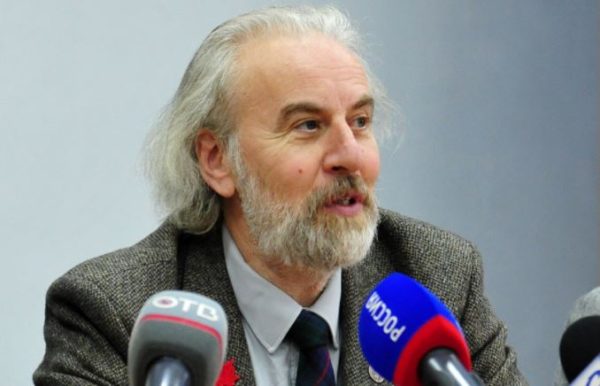
Many of Dvorkin’s criticisms of Scientology have echoed those of Western anti-cult groups. Like them, he has characterised it as a destructive cult that engages in brainwashing and mind control. He has also echoed German concerns that Scientology was a threat to national security – an issue that led the German government to place Scientology under surveillance by the German domestic intelligence service in 1997. In his view, Scientology and other sects are “criminal organisations” and “mafiosi structures” aiming at “seizing state power” and destroying democratic institutions. Dvorkin has denounced Scientology as “totally evil” and has claimed that it is connected to the US secret services. (In reality, as internal Scientology documents show, it has a history of being deeply hostile to them, as L. Ron Hubbard regarded them as enemies).
The Russian Orthodox Church’s intense criticism of Scientology and other movements such as the Jehovah’s Witnesses, Moonies and Aum Shinrikyo led to the gradual political delegitimisation of such groups. Powerful Russian social, cultural and political forces shared a common interest in opposing foreign sects. As well as the Orthodox Church, members of other Russian ethnic and religious groups also saw threats to their groups’ social and political integrity. Politicians and officials increasingly echoed anti-cult rhetoric in their public comments.
Russian psychiatrists offered ‘scientific’ backing for anti-cult positions: adherence to traditional religions was portrayed as socially normal while membership of new religious movements was characterised as socially and psychologically pathological. Such groups were described as “mafia sects” and their members as “secto-maniacs”. The Russian media, at the time a mixture of independent and state-owned outlets, became increasingly hostile towards groups such as Scientology.
The church experienced further setbacks as the Internet made it much easier for Russians to access Western anti-Scientology information. In the city of Novgorod, a Hubbard College had become highly influential locally with the backing of the giant Altron chemical works. Hundreds of local public administrators were trained there in Scientology ‘management technology’ between 1994 and 1996.
However, Scientology’s run of success in Novgorod ended when a local television director chanced upon a copy of Time magazine’s blockbuster May 1991 story on “the cult of greed and power”. He began speaking out via local media outlets. After a few months of bad publicity, the provincial administration severed ties with Scientology in early 1997. It disowned the training its staff had received and evicted the Hubbard College from its spacious premises in the city centre.
Scientology pushed back with the usual Hubbardian tactics of attacking its opponents. Dvorkin, who was identified by OSA chief Alisich in 1996 as a principal source of anti-Scientology ‘entheta’, says that his email has been hacked in retaliation and his acquaintances harassed. He also faced unsuccessful lawsuits and threats. According to Dvorkin, he was visited by OSA’s PR chief in Russia, Birthe Heldt, who told him: “We would like you to know that anybody standing in the way of Scientology ends up very badly.” “Are you threatening me?” he asked. “No, just warning you,” she replied.
Other anti-cult campaigners were also targeted. A parents’ committee and Duma deputy Nadezhda Krivelskaya were identified as key elements of the Russian “Anti-Religious Movement” (Scientology’s collective term for its critics). They were made targets for intelligence-gathering (“develop info lines”) and targeted with “dead agent” smear tactics.” According to a leaked cable signed by Heldt in January 1998, OSA CIS sought to “investigate Krivelskaya and get data exposed on proper lines (via ally lines).” Scientology established a front group called “Parents Against Totalitarian Thinking”, with no apparent sense of irony, to rebut the anti-Scientology parents’ complaints.
Presumably anticipating police raids, OSA CIS also aimed to upgrade its security “to prevent enemy from gaining any materials that could be misinterpreted and turned against us. This concerns computer data and computer disks, PC [preclear] files, lifehistories, any special data (dep 20) [i.e. OSA]”). This does not seem to have been a successful effort. Documents apparently seized from Scientology by the FSB were marked “Highly Confidential – Do not store in printed form” and were held on a (possibly encrypted) hard drive. However, the FSB’s highly capable technicians were more than capable of recovering the material.
The events in Novgorod were indicative of an increasingly hostile stance by the Russian authorities. This trend started well before Putin’s rise and often reflected local concerns rather than pressure from the national leadership. Some local politicians were wary from the start of tangling with Scientology. When Boris Nemtsov, then the governor of Nizhny Novgorod, was asked to open the Hubbard College in his region’s capital in 1993, he wrote an obscene word in his diary and declined the invitation.
Others responded to growing pressure from the Russian Orthodox Church by legislating against non-Orthodox sects. Between 1993 and 1997, a third of Russia’s 83 federal regions passed legislation against missionary activity by sects. Some went further; the Sverdlovsk region in western Siberia closed down its two Hubbard Colleges in October 1996. Scientology’s involvement in drug and alcohol rehabilitation was the subject of exposés by the Russian media which led to the Russian government banning government agencies from using Hubbard’s drug treatment methods. An exposé by the Orthodox student newspaper Tatyanin den’ resulted in the Moscow State University renaming its L. Ron Hubbard Reading Room and ending the link to Scientology.
Pressure also grew in Russia’s parliament. In December 1996, the parliament’s lower house, the State Duma, passed a resolution appealing to President Yeltsin “regarding the dangerous consequences of the influence of certain religious organisations on the health of Russian society, families and citizens”. It highlighted Scientology, whose operations it said “resemble the actions of special [intelligence] services … It is known to have penetrated high-security enterprises in the city of Obniinsk and military-industrial enterprises in various Russian regions.”
The following year, the Duma passed a new Law on Freedom of Conscience and Religious Associations to overhaul the earlier law inherited from the Soviet Union. It explicitly granted the Russian Orthodox Church a privileged role due to “the special role of Orthodoxy in the history of Russia”. Faith groups other than those traditionally recognised in Russia (Orthodox Christianity, Judaism, Islam and Buddhism) were placed under tighter regulations.
The new law drew a distinction between officially-registered “religious organisations” and unregistered “religious groups”. Religious groups needed to have existed for 15 years before they could register as a religious organisation. All existing approved groups were required to re-register. State-recognised religious organisations could own property, employ people, conduct religious services and carry out charity work, but unregistered religious groups were given no such rights. They could be dissolved if they were deemed to violate public security and order, incite racial, national or religious enmity, or threaten morality and health. The criteria for these offences are very broad and deliberately vague; this has allowed a wide range of interpretations by courts and officials.
Not surprisingly, the law was explicitly directed against groups such as Scientology, which was denied permission to re-register. One of its authors, Communist Party deputy Viktor Zorkaltev, told the Duma that it “creates a barrier in the path of religious expansion into Russia, hinders the development of totalitarian sects, [and] restricts the action of foreign missionaries.” Scientology nonetheless anticipated a move of this nature. In March 1996, Russian OSA head Dietholm Alisich wrote that Scientology was stepping up the training of Russian Sea Org members. The goal was to ensure they could “could stand on their own two feet even if all foreign SO members get kicked out of Russia”. “Dianetics has been engrained [sic] in Russia to a degree that it cannot ever be taken out again,” he wrote. “It is too far spread already to be able to kill it off again.”
The passage of the law came during a backlash against the excesses and social disintegration of the Yeltsin era. The “wild capitalism” of the 1990s saw much of the formerly state-owned economy being taken over by well-connected individuals and former party insiders. Millions lost their jobs as loss-making industries were closed down. Crime and corruption became commonplace and bloody wars broke out in the Caucasus. Life expectancies plummeted, drug and alcohol addiction rocketed, and living standards fell precipitously.
The period was so traumatic that for many Russians, the implicit bargain offered by Vladimir Putin when he took over in August 1999 – stability and improved living standards in exchange for acceptance of a more autocratic style of rule – seemed like a good deal. For Scientology, though, his accession to the presidency marked the start of an increasingly difficult relationship with the Russian state.
— Chris Owen
——————–
Leigh still giving speeches
While her Facebook account still hasn’t had any content since Jan 7, the day after the riots, we do have a Leigh Dundas sighting, and thought we’d add it to today’s post.
On Jan 16, she appeared at the Free & The Brave conference at the Church of Glad Tidings in Live Oak, California.
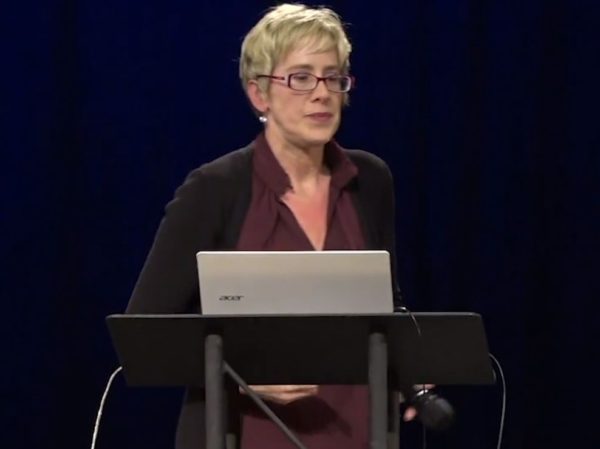
If you happen upon any other news of her, please let us know.
——————–
“Nineteen fifty-one, I rolled up my sleeves and started to investigate the Whole Track. Because in late 1950 it had started to raise its ugly and unseemly head. And auditors who would run into it and try to audit it and pcs who dare bring it up, of course, ran into a considerable social ostracism of one character or another. That was not done. The first Foundation board tried to pass a regulation, a board ruling to the effect that nobody would ever look at, believe in or investigate past lives, and so forth. And yet auditors in auditing them kept running into them, you see? So that probably was the basic split-up of the first Foundation. The first Foundation wanted to sit there comfortably and just grind on and on in present-life engrams and consider that we had it all made and they wanted no further research or investigation of any kind whatsoever. Well, that wouldn’t go and that was that, because auditors were not turning out the results they should have turned out if one had only lived one life. So in 1951 this — I didn’t fly in the teeth of this. I would have investigated anything. I mean, there’s no real resistance on my part. You show me something, tell me I can’t investigate it, I’m liable to investigate it. You show me something and tell me I can investigate it, I’m liable to investigate it. I mean, there is no influence in that line. I, just down through the trillennia, I have not paid attention to and/or paid no attention to people who have told me not to look. I just have not paid any attention to this one way or the other. This, of course, adds up to a total neglect of the ‘finer sensibilities,’ I think they’re called, of other people. The finer sensibilities, I think, is another way of expressing the idea ‘he’s too yellow to look.’” — L. Ron Hubbard, January 25, 1962
——————–
“If you can tolerate running your legs off, getting grey hairs, bags under your eyes, streteched wits in the course of a day’s work amongst the living lightning, these could be a place for you in the Office of the LRH Comm Flagship. You’ve no idea what it takes at times to get an order duplicated, activated, executed and completed! Cats with some lives left who want it hot and dangerous can volunteer for the hottest spot aboard. Drop me a line — today — saying WHY you want a job with LRH Comm Flagship and I’ll look it over.” — LRH Comm Flagship, January 25, 1971
——————–
“Recently a friend of mine had a crash, he told his mother and his mother fell to the ground an hour later, injuring herself. She had an accident, which is a PTS condition according to Scientology theory. There must also be an SP, according to the same theory, but, who’s suppressing her in that case? See? She had an accident, which links to a PTS condition, but the triggering was to be told bad news, to be told by his son that he had just crashed. Yes, she might also be connected to antagonistic terminals in present time as well as in the Whole Track, but the trigger at that incident was to learn about the crash. You can examine your own life and see if that’s true for you.”
——————–
2002: Celebrity Magazine reported that Kirstie Alley has opened two new reading centers in California, and that a benefit event was held in Los Angeles to raise money for Scientology volunteer ministers. “The grand opening of the first new Lillie’s was at the Mission of Beverly Hills. Present were Jennifer Aspen and Lynsey Bartilson as well as hundred of attendees ranging from Scientologists to local community leaders and non-Scientology celebrities. The second Lillie’s was opened at the Mission of Riverpark, in Sacramento, California, the very next day. Among those attending were Jenna Elfman and Kate Ceberano. Lillie’s Learning Place provides tutoring for anyone who wishes to improve their ability to study, by utilizing L. Ron Hubbard’s Study Tech. Also taught is a phonics-based reading program for anyone wanting to improve their ability to read, as well as a thorough, easy-to-learn course on grammar. Kirstie’s plans now include opening up four more Lillie’s in the months to come.”
“People say to me, ‘So, have you met a Scientologist?’ And I laugh and think to myself, ‘What a beautiful thing,’ because maybe one day it will be like that, you know? You know what I’m saying. Maybe one day it will be that ‘Wow, Scientologists, they just read about those in the history books.’ You know?”
——————–
Full Court Press: What we’re watching at the Underground Bunker
Criminal prosecutions:
— Danny Masterson charged for raping three women: Masterson arraigned Jan 20. Next conf to set prelim, March 24.
— Jay and Jeff Spina, Medicare fraud: Jay’s sentencing delayed to March 2.
— Hanan and Rizza Islam and other family members, Medi-Cal fraud: Trial scheduled for May 20 in Los Angeles
Civil litigation:
— Luis and Rocio Garcia v. Scientology: Oral arguments were heard on July 30 at the Eleventh Circuit
— Valerie Haney v. Scientology: Forced to ‘religious arbitration.’ Petition for writ of mandate denied Oct 22 by Cal 2nd Appellate District. Petition for review by state supreme court denied Dec 11.
— Chrissie Bixler et al. v. Scientology and Danny Masterson: Dec 30, Judge Kleifield granted Scientology’s motions to compel arbitration. Jan 29: Status conference.
— Matt and Kathy Feschbach tax debt: Eleventh Circuit ruled on Sept 9 that Feshbachs can’t discharge IRS debt in bankruptcy. Dec 17: Feshbachs sign court judgment obliging them to pay entire $3.674 million tax debt, plus interest from Nov 19.
— Brian Statler Sr v. City of Inglewood: Second amended complaint filed, trial set for Nov 9, 2021.
Concluded litigation:
— Author Steve Cannane defamation trial: Trial concluded, Cannane victorious, awarded court costs.
— Dennis Nobbe, Medicare fraud, PPP loan fraud: Charged July 29. Bond revoked Sep 14. Nobbe dead, Sep 14.
— Jane Doe v. Scientology (in Miami): Jane Doe dismissed the lawsuit on May 15 after the Clearwater Police dropped their criminal investigation of her allegations.
——————–
 SCIENTOLOGY BLACK OPS: Tom Cruise and dirty tricks
SCIENTOLOGY BLACK OPS: Tom Cruise and dirty tricks
The Australian Seven News network cancelled a 10-part investigation of Scientology and its history of dirty tricks. Read the transcripts of the episodes and judge for yourself why Tom Cruise and Tommy Davis might not have wanted viewers to see this hard-hitting series by journalist Bryan Seymour.
After the success of their double-Emmy-winning, three-season A&E series ‘Scientology and the Aftermath,’ Leah Remini and Mike Rinder continue the conversation on their podcast, ‘Scientology: Fair Game.’ We’ve created a landing page where you can hear all of the episodes so far.
 LEAH REMINI: SCIENTOLOGY AND THE AFTERMATH
LEAH REMINI: SCIENTOLOGY AND THE AFTERMATH
An episode-by-episode guide to Leah Remini’s three-season, double-Emmy winning series that changed everything for Scientology watching. Originally aired from 2016 to 2019 on the A&E network, and now on Netflix.
 SCIENTOLOGY’S CELEBRITIES, from A to Z
SCIENTOLOGY’S CELEBRITIES, from A to Z
Find your favorite Hubbardite celeb at this index page — or suggest someone to add to the list!
Other links: Scientology’s Ideal Orgs, from one end of the planet to the other. Scientology’s sneaky front groups, spreading the good news about L. Ron Hubbard while pretending to benefit society. Scientology Lit: Books reviewed or excerpted in a weekly series. How many have you read?
——————–
THE WHOLE TRACK
[ONE year ago] My mom is the auditor in the ‘Reckless Ben’ Scientology infiltration videos
[TWO years ago] Scientology’s ‘grass roots’ social media effort is actually led by its most mediocre spokesman
[THREE years ago] The Battle of Portland, part 2: Pressuring a court by surrounding it with Scientologists and celebs
[FOUR years ago] Brandon Reisdorf: Scientology complained to probation dept. over ‘Leah Remini’ appearance
[FIVE years ago] For a class-action lawsuit against Scientology’s rehab network, a setback in California
[SIX years ago] ‘Going Clear’ premieres at Sundance, and we watched in awe with the celebs
[SEVEN years ago] Jon Atack: Do Scientology’s training routines turn you into a sociopath?
[EIGHT years ago] Newsweek Confirms It: L. Ron Hubbard Was a Blowhard
[NINE years ago] The Strange Death of Flo Barnett, Mother-in-Law to Scientology Leader David Miscavige
——————–
Bernie Headley (1952-2019) did not see his daughter Stephanie in his final 5,667 days.
Valerie Haney has not seen her mother Lynne in 2,192 days.
Katrina Reyes has not seen her mother Yelena in 2,696 days
Sylvia Wagner DeWall has not seen her brother Randy in 2,216 days.
Brian Sheen has not seen his grandson Leo in 1,236 days.
Geoff Levin has not seen his son Collin and daughter Savannah in 1,127 days.
Christie Collbran has not seen her mother Liz King in 4,434 days.
Clarissa Adams has not seen her parents Walter and Irmin Huber in 2,302 days.
Carol Nyburg has not seen her daughter Nancy in 3,076 days.
Jamie Sorrentini Lugli has not seen her father Irving in 3,880 days.
Quailynn McDaniel has not seen her brother Sean in 3,196 days.
Dylan Gill has not seen his father Russell in 11,762 days.
Melissa Paris has not seen her father Jean-Francois in 7,681 days.
Valeska Paris has not seen her brother Raphael in 3,849 days.
Mirriam Francis has not seen her brother Ben in 3,430 days.
Claudio and Renata Lugli have not seen their son Flavio in 3,691 days.
Sara Goldberg has not seen her daughter Ashley in 2,729 days.
Lori Hodgson has not seen her son Jeremy and daughter Jessica in 2,442 days.
Marie Bilheimer has not seen her mother June in 1,967 days.
Julian Wain has not seen his brother Joseph or mother Susan in 322 days.
Charley Updegrove has not seen his son Toby in 1,497 days.
Joe Reaiche has not seen his daughter Alanna Masterson in 6,048 days
Derek Bloch has not seen his father Darren in 3,197 days.
Cindy Plahuta has not seen her daughter Kara in 3,517 days.
Roger Weller has not seen his daughter Alyssa in 8,372 days.
Claire Headley has not seen her mother Gen in 3,491 days.
Ramana Dienes-Browning has not seen her mother Jancis in 1,847 days.
Mike Rinder has not seen his son Benjamin and daughter Taryn in 6,150 days.
Brian Sheen has not seen his daughter Spring in 2,256 days.
Skip Young has not seen his daughters Megan and Alexis in 2,658 days.
Mary Kahn has not seen her son Sammy in 2,530 days.
Lois Reisdorf has not seen her son Craig in 2,113 days.
Phil and Willie Jones have not seen their son Mike and daughter Emily in 2,608 days.
Mary Jane Barry has not seen her daughter Samantha in 2,862 days.
Kate Bornstein has not seen her daughter Jessica in 13,971 days.
——————–
 Posted by Tony Ortega on January 25, 2021 at 07:00
Posted by Tony Ortega on January 25, 2021 at 07:00
E-mail tips to tonyo94 AT gmail DOT com or follow us on Twitter. We also post updates at our Facebook author page. After every new story we send out an alert to our e-mail list and our FB page.
Our new book with Paulette Cooper, Battlefield Scientology: Exposing L. Ron Hubbard’s dangerous ‘religion’ is now on sale at Amazon in paperback and Kindle formats. Our book about Paulette, The Unbreakable Miss Lovely: How the Church of Scientology tried to destroy Paulette Cooper, is on sale at Amazon in paperback, Kindle, and audiobook versions. We’ve posted photographs of Paulette and scenes from her life at a separate location. Reader Sookie put together a complete index. More information can also be found at the book’s dedicated page.
The Best of the Underground Bunker, 1995-2020 Just starting out here? We’ve picked out the most important stories we’ve covered here at the Underground Bunker (2012-2020), The Village Voice (2008-2012), New Times Los Angeles (1999-2002) and the Phoenix New Times (1995-1999)
Other links: BLOGGING DIANETICS: Reading Scientology’s founding text cover to cover | UP THE BRIDGE: Claire Headley and Bruce Hines train us as Scientologists | GETTING OUR ETHICS IN: Jefferson Hawkins explains Scientology’s system of justice | SCIENTOLOGY MYTHBUSTING: Historian Jon Atack discusses key Scientology concepts | Shelly Miscavige, 15 years gone | The Lisa McPherson story told in real time | The Cathriona White stories | The Leah Remini ‘Knowledge Reports’ | Hear audio of a Scientology excommunication | Scientology’s little day care of horrors | Whatever happened to Steve Fishman? | Felony charges for Scientology’s drug rehab scam | Why Scientology digs bomb-proof vaults in the desert | PZ Myers reads L. Ron Hubbard’s “A History of Man” | Scientology’s Master Spies | The mystery of the richest Scientologist and his wayward sons | Scientology’s shocking mistreatment of the mentally ill | The Underground Bunker’s Official Theme Song | The Underground Bunker FAQ
Watch our short videos that explain Scientology’s controversies in three minutes or less…
Check your whale level at our dedicated page for status updates, or join us at the Underground Bunker’s Facebook discussion group for more frivolity.

Our non-Scientology stories: Robert Burnham Jr., the man who inscribed the universe | Notorious alt-right inspiration Kevin MacDonald and his theories about Jewish DNA | The selling of the “Phoenix Lights” | Astronomer Harlow Shapley‘s FBI file | Sex, spies, and local TV news | Battling Babe-Hounds: Ross Jeffries v. R. Don Steele








